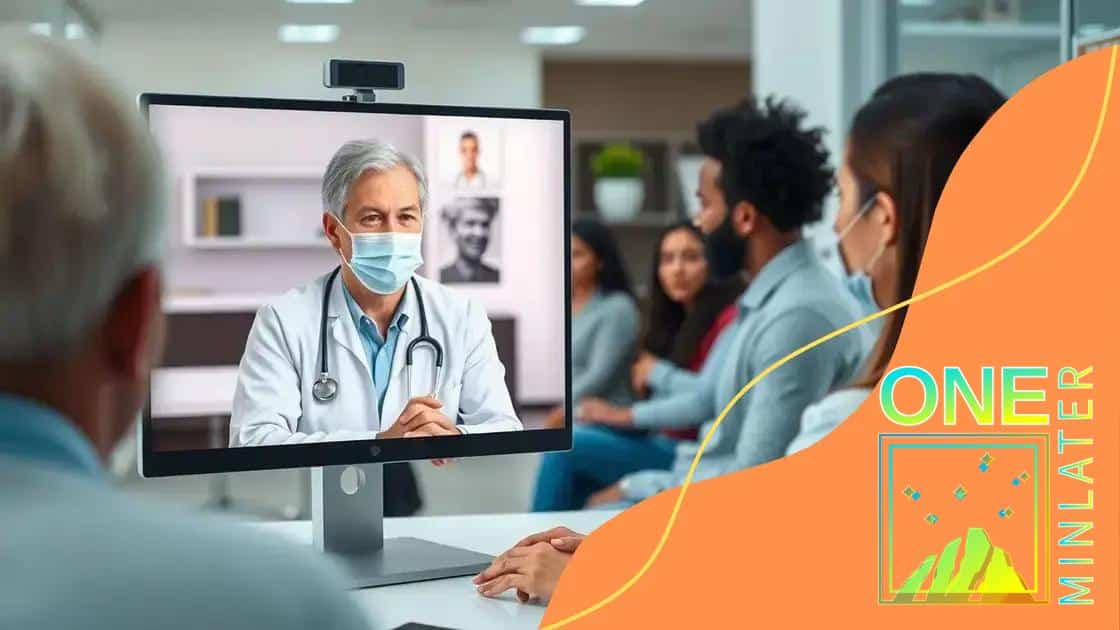Expanding access to healthcare benefits for low-income workers

Expanding access to healthcare benefits for low-income workers involves addressing financial barriers, offering employer-sponsored health programs, and implementing community initiatives to improve healthcare access and overall well-being.
Expanding access to healthcare benefits for low-income workers can significantly impact communities. Have you thought about how better access could improve health outcomes? Let’s delve into the challenges and solutions.
Understanding the current landscape of healthcare access
Understanding the current landscape of healthcare access is crucial for addressing the needs of low-income workers. Today, many individuals face barriers that keep them from receiving proper healthcare. These barriers may include affordability, transportation issues, and a lack of knowledge about available services.
Barriers to Healthcare Access
One major barrier is affordability. Many low-income workers struggle to pay for insurance, even if it is subsidized. Furthermore, high copays and deductibles can deter them from seeking necessary care. This leads to untreated health issues, which can accumulate and worsen over time.
- Transportation difficulties prevent access to healthcare facilities.
- Limited understanding of insurance options creates confusion.
- Healthcare providers may be located far from low-income neighborhoods.
- Work schedules may clash with office hours of healthcare facilities.
Moreover, low-income workers often lack access to workplace benefits that could improve their healthcare situation. Employers play a key role in providing resources that can help their employees navigate these challenges effectively. For instance, some companies offer services that link workers to local healthcare resources, enhancing their awareness and utilization.
Innovative Solutions Emerging
Fortunately, several innovative solutions are emerging to improve access to healthcare. Telehealth has become increasingly popular, allowing individuals to consult with healthcare professionals via the internet. This is particularly advantageous for those with transportation challenges.
In addition, community health centers are focusing on serving low-income populations, providing a variety of essential services at reduced costs. These centers often offer sliding scale fees based on income, making them more accessible.
Moreover, initiatives promoting health literacy seek to educate individuals about their healthcare options and rights. By empowering low-income workers with knowledge, they can make informed choices about their health and well-being.
Challenges faced by low-income workers
Low-income workers face a variety of challenges that significantly impact their access to healthcare. Understanding these challenges is essential for developing effective solutions. Many of these individuals struggle daily with complex issues that can obstruct their ability to seek the medical care they need.
Financial Constraints
One of the primary challenges is financial constraints. Healthcare costs can add up quickly, making it hard for low-income workers to afford necessary treatments. Even with insurance, high deductibles and copayments can be barriers. This often leads to individuals choosing to skip visits to the doctor, which can exacerbate health issues over time.
- Out-of-pocket expenses become unaffordable for many families.
- Insurance plans may not cover all necessary services.
- Surprise medical bills can lead to financial crises.
- The cost of medications can be prohibitive.
In addition to financial barriers, low-income workers often encounter limited access to transportation. Many healthcare facilities are not conveniently located, and public transportation options may be inadequate or unavailable. As a result, getting to medical appointments can be a daunting task, which further discourages individuals from seeking care.
Furthermore, a lack of health education contributes to the problem. Many low-income workers are unaware of what services are available to them or how to navigate the healthcare system effectively. This confusion can prevent individuals from making informed decisions about their health and leads to missed opportunities for preventive care.
Job Insecurity
Another challenge is job insecurity. Many low-income workers are employed in positions that do not offer stable hours or health benefits. This uncertainty can make it difficult for individuals to plan doctor visits around their unpredictable work schedules. When healthcare benefits are not provided, it adds further stress to workers trying to care for themselves and their families.
Lastly, the stigma surrounding low-income status can affect mental health. Many individuals feel embarrassed or ashamed when seeking help, which can further alienate them from necessary healthcare services. Addressing these challenges requires a holistic approach that considers both the financial and social barriers to healthcare access.
Innovative solutions for better healthcare access

Innovative solutions for better healthcare access are essential for improving the situation of low-income workers. As challenges mount, organizations and communities are stepping up to offer creative alternatives that can bridge gaps and enhance the quality of care.
Telehealth Services
One major advancement is the rise of telehealth services. This technology allows patients to consult with healthcare providers from the comfort of their homes. Using phones or computers, individuals have easier access to medical advice without needing to travel.
- Telehealth offers convenience, especially for those with transportation issues.
- It reduces waiting times to see a doctor.
- Patients can consult specialists without traveling far.
- Follow-up appointments can be managed quickly and efficiently.
These benefits make telehealth particularly valuable for low-income workers who may struggle with traditional healthcare barriers. With a simple internet connection, they can receive necessary care, advice, and even prescriptions.
Community Health Initiatives
Another innovative approach involves community health initiatives. These programs often work directly within low-income neighborhoods to provide healthcare services and education. Community health workers play a critical role in connecting individuals to local resources.
Programs may include health fairs, workshops on preventing chronic diseases, and screening for common health issues. By bringing services directly to the community, these initiatives make healthcare more accessible and effective.
Additionally, partnerships between employers and local health organizations can create on-site health clinics. These clinics provide employees with easy access to medical care during work hours, lowering barriers and encouraging workers to seek care.
Mobile Health Units
Mobile health units are another exciting innovation. These vehicles travel to underserved areas, bringing healthcare services where they are most needed. Equipped with essential medical equipment, mobile units can offer vaccinations, check-ups, and health screenings.
They are especially beneficial for workers who may not be able to visit traditional healthcare facilities due to time constraints. Mobile health units ensure that no one is left behind when it comes to accessing vital health services.
The role of employers in providing benefits
The role of employers in providing benefits is crucial for low-income workers. Many employees rely on their jobs for insurance and healthcare support. By offering comprehensive benefits, employers can create a healthier workforce and improve employee satisfaction.
Offering Health Insurance
One of the primary ways employers support their employees is by providing health insurance. This can significantly reduce the financial burden of medical expenses for low-income workers. When employers offer health plans, they should consider providing options that are affordable and cover a broad range of services.
- Include preventive care in insurance plans to help catch issues early.
- Offer multiple plan options to meet diverse needs.
- Educate employees about their benefits for easier access.
When employees understand their health insurance options, they are more likely to use these benefits, leading to better health outcomes. This proactive approach can reduce overall healthcare costs for both employees and employers.
Flexible Work Arrangements
Employers can also play a role through flexible work arrangements. By allowing employees to adjust their schedules, workers can attend medical appointments without worrying about losing pay. Flexibility can include remote work options or adjustable hours, which are especially beneficial for those with families.
Additionally, employers might provide paid time off for medical appointments. This policy allows low-income workers to seek healthcare without the stress of potential financial repercussions. Access to mental health resources is equally important. Employers can organize workshops or provide support lines to help employees address mental health issues. This support can improve overall workplace morale.
Wellness Programs
Many companies invest in wellness programs that focus on preventive care. These programs can include health screenings, fitness classes, and nutritional workshops. Ensuring low-income workers have access to these initiatives encourages a culture of health and wellness.
Such programs not only promote healthier lifestyles but also demonstrate that employers care about their employees’ well-being. When workers feel valued, productivity and job satisfaction typically increase, creating a positive cycle for both the employees and the company.
Real-life examples of successful initiatives
Real-life examples of successful initiatives showcase how innovative solutions can improve healthcare access for low-income workers. These initiatives demonstrate the power of community support and the impact of strategic partnerships in overcoming barriers to care.
Community Outreach Programs
Many cities have launched community outreach programs aimed at connecting low-income workers with essential health services. For instance, a program in Los Angeles set up pop-up clinics in underprivileged neighborhoods, providing free health screenings, vaccinations, and health education. These clinics operate on weekends to accommodate working individuals, ensuring that everyone has the chance to access crucial health services.
- Free screenings for blood pressure, diabetes, and cholesterol.
- Educational workshops focused on healthy eating and preventive care.
- Referral services to local healthcare facilities for further treatment.
Community outreach not only brings care to underserved areas but also empowers individuals by educating them about their health options.
Employer-Sponsored Health Fairs
Another innovative initiative is the organization of employer-sponsored health fairs. Companies can collaborate with local health providers to host events that offer employees free or discounted services. These fairs often feature flu shots, health screenings, and fitness consultations.
Such initiatives encourage employees to take charge of their health while enhancing workplace wellness. By fostering a culture of health awareness, employers demonstrate their commitment to the well-being of their workers, which can lead to increased job satisfaction and productivity.
Mobile Health Units
Mobile health units are becoming increasingly popular as a way to reach those who may have trouble accessing traditional healthcare providers. For instance, a nonprofit organization in Chicago operates a mobile clinic that travels to various neighborhoods, providing services such as primary care, dental check-ups, and mental health support.
By bringing healthcare directly to communities, these units help eliminate transportation barriers. People can receive care in familiar environments, which can reduce anxiety and increase the likelihood of seeking help.
Telehealth Innovations
Telehealth has transformed the way many low-income workers access healthcare, especially during the pandemic. Many healthcare providers now offer virtual consultations, which can be a game-changer for those with limited access to transportation or time to visit a clinic. A successful program in New York City has implemented telehealth services specifically for low-income populations, ensuring they can receive timely medical advice without the need for travel.
These examples highlight how targeted initiatives can improve healthcare access for low-income workers, ensuring that they receive the essential care they need.
In conclusion, expanding access to healthcare benefits for low-income workers is essential for improving their overall well-being. By understanding the challenges they face and implementing innovative solutions, we can create a healthier workforce. Employers play a vital role by offering comprehensive benefits, flexible work arrangements, and wellness programs that support their employees. Real-life examples show how targeted initiatives can make a significant difference. As we move forward, it is crucial to continue advocating for equitable healthcare access that meets the needs of everyone.
FAQ – Frequently Asked Questions about Expanding Access to Healthcare Benefits for Low-Income Workers
What are the main challenges faced by low-income workers regarding healthcare?
Low-income workers often face challenges like financial constraints, limited access to transportation, and a lack of health education, making it hard to seek necessary care.
How can employers help improve healthcare access for their employees?
Employers can offer comprehensive health insurance, flexible work arrangements, and wellness programs, which can encourage employees to use healthcare services.
What role do community health initiatives play in improving access?
Community health initiatives bring essential services directly to underserved populations, increasing awareness and utilization of healthcare resources.
How has telehealth changed the way low-income workers access healthcare?
Telehealth allows low-income workers to consult with healthcare providers remotely, eliminating the need for travel and making healthcare more accessible.





